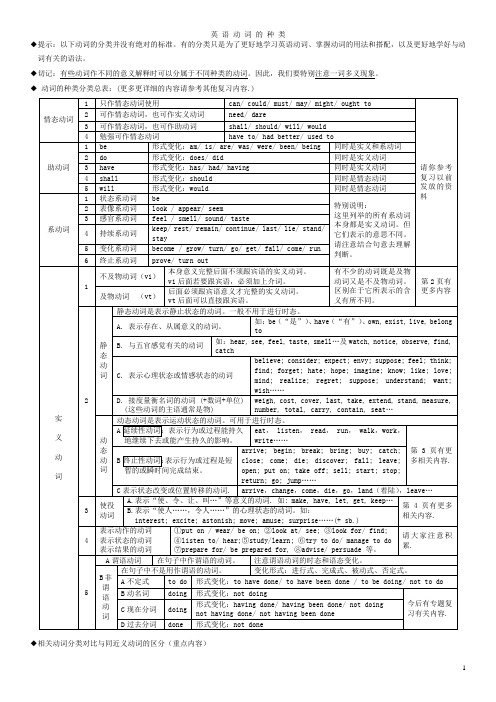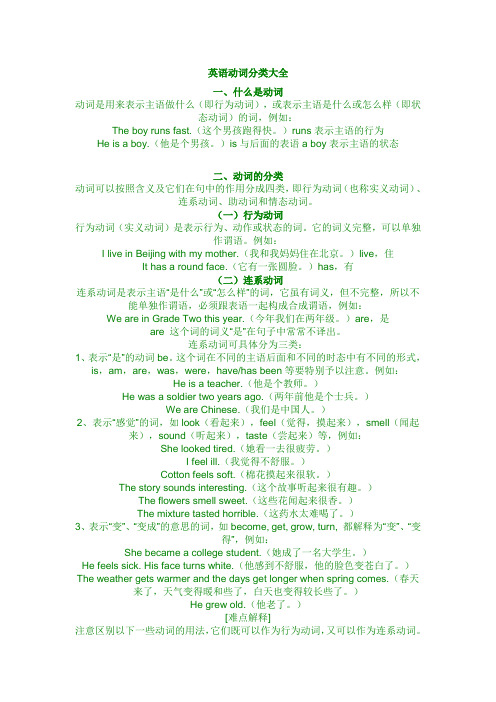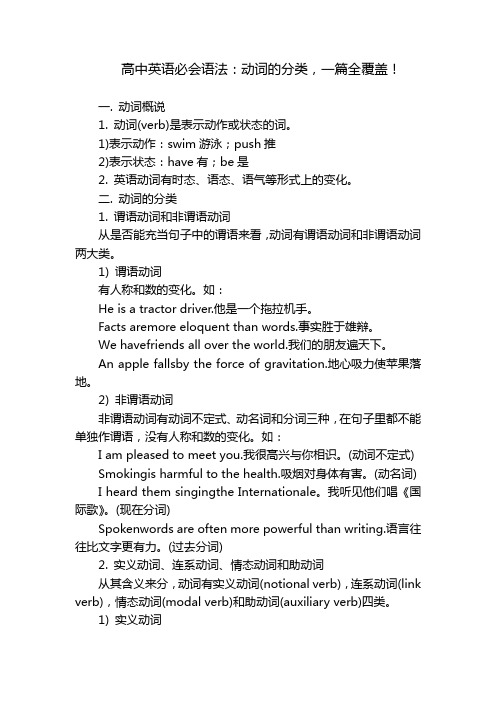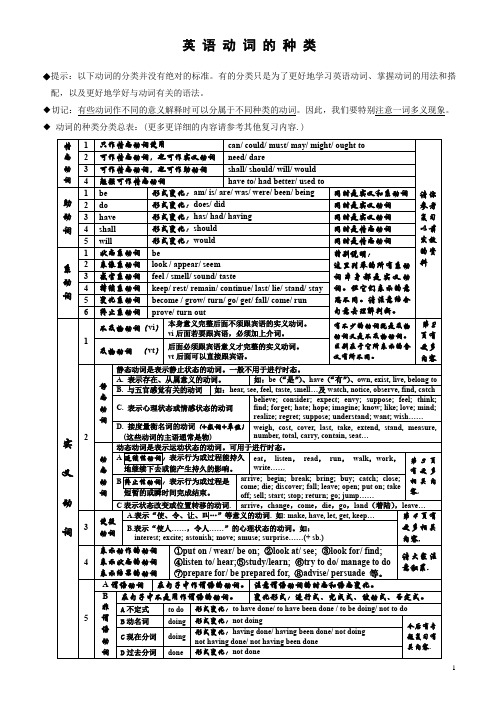英语动词分类
英语动词分类表

如:hear, see, feel, taste, smell…及 watch, notice, observe, find, catch
believe; consider; expect; envy; suppose; feel; think;
C. 表示心理状态或情感状态的动词
find; forget; hate; hope; imagine; know; like; love; mind; realize; regret; suppose; understand; want;
请大家注意积 累.
A 谓语动词 在句子中作谓语的动词。 注意谓语动词的时态和语态变化。
在句子中不是用作谓语的动词。
变化形式:进行式、完成式、被动式、否定式。
B 非 A 不定式
5
谓 语 B 动名词
to do 形式变化:to have done/ to have been done / to be doing/ not to do doing 形式变化:not doing
depend + on
operate +on
rely + on
insist + on doing
live +in/on belong + to sb come + to sb go + to happen +to sb lie + to/in listen + to object +to occur +to refer +to relate +to reply +to return +to stick +to sth graduate + from suffer +from
动词分类

动词的分类用法一、动词的种类1、实义动词(1)定义实义动词是有实在意义并能独立作谓语的动词。
(2)分类按句法作用可分为及物动词vt.和不及物动词vi.;按动作状态可分为延续性动词和非延续性动词(瞬间性动词)。
(3)用法a. 及物动词 vt.及物动词本身意义不完整,需要接宾语才能使其意思完整。
如: I like this book very much. (接宾语)We call the bird Polly.(接宾语+宾补)Please pass me the salt.(接间接宾语+直接宾语)b. 不及物动词 vi.不及物动词自身意思完整,不需要接宾语。
如:Horses run fast.They work in a factory.<注> 有些不及物动词和其他词搭配构成动词词组可以相当于及物动词使用。
动词+介词+宾语(名词&代词)Look at the blackboard. / Listen to me carefully.动词+副词+宾语(名词)&动词+宾语(代词)+副词Please turn off the light. He picked it up and gave it to me.动词+副词+介词+宾语(名词&代词)Alice gets along well with her classmates.动词+名词+介词+宾语(名词&代词)Please pay attention to my reading.c.延续性动词延续性动词表示动作是可持续的,可以和表示一段时间的时间状语连用。
如:We have lived in China for many years.<注>常用的延续性动词有live, stay, study, work, keep, teach等。
d. 非延续性动词非延续性动词表示瞬间动作,动作已经发生便立即结束。
如:I have finished my homework.<注>常用的非延续性动词有buy, lend, borrow, die, begin, stop, finish, arrive, join, go, come, catch等。
英语动词分类大全

英语动词分类大全一、什么是动词动词是用来表示主语做什么(即行为动词),或表示主语是什么或怎么样(即状态动词)的词,例如:The boy runs fast.(这个男孩跑得快。
)runs表示主语的行为He is a boy.(他是个男孩。
)is与后面的表语a boy表示主语的状态二、动词的分类动词可以按照含义及它们在句中的作用分成四类,即行为动词(也称实义动词)、连系动词、助动词和情态动词。
(一)行为动词行为动词(实义动词)是表示行为、动作或状态的词。
它的词义完整,可以单独作谓语。
例如:I live in Beijing with my mother.(我和我妈妈住在北京。
)live,住It has a round face.(它有一张圆脸。
)has,有(二)连系动词连系动词是表示主语“是什么”或“怎么样”的词,它虽有词义,但不完整,所以不能单独作谓语,必须跟表语一起构成合成谓语,例如:We are in Grade Two this year.(今年我们在两年级。
)are,是are 这个词的词义“是”在句子中常常不译出。
连系动词可具体分为三类:1、表示“是”的动词be。
这个词在不同的主语后面和不同的时态中有不同的形式,is,am,are,was,were,have/has been等要特别予以注意。
例如:He is a teacher.(他是个教师。
)He was a soldier two years ago.(两年前他是个士兵。
)We are Chinese.(我们是中国人。
)2、表示“感觉”的词,如look(看起来),feel(觉得,摸起来),smell(闻起来),sound(听起来),taste(尝起来)等,例如:She looked tired.(她看一去很疲劳。
)I feel ill.(我觉得不舒服。
)Cotton feels soft.(棉花摸起来很软。
)The story sounds interesting.(这个故事听起来很有趣。
高中英语必会语法:动词的分类,一篇全覆盖!

高中英语必会语法:动词的分类,一篇全覆盖!一. 动词概说1. 动词(verb)是表示动作或状态的词。
1)表示动作:swim游泳;push推2)表示状态:have有;be是2. 英语动词有时态、语态、语气等形式上的变化。
二. 动词的分类1. 谓语动词和非谓语动词从是否能充当句子中的谓语来看,动词有谓语动词和非谓语动词两大类。
1) 谓语动词有人称和数的变化。
如:He is a tractor driver.他是一个拖拉机手。
Facts aremore eloquent than words.事实胜于雄辩。
We havefriends all over the world.我们的朋友遍天下。
An apple fallsby the force of gravitation.地心吸力使苹果落地。
2) 非谓语动词非谓语动词有动词不定式、动名词和分词三种,在句子里都不能单独作谓语,没有人称和数的变化。
如:I am pleased to meet you.我很高兴与你相识。
(动词不定式)Smokingis harmful to the health.吸烟对身体有害。
(动名词)I heard them singingthe Internationale。
我听见他们唱《国际歌》。
(现在分词)Spokenwords are often more powerful than writing.语言往往比文字更有力。
(过去分词)2. 实义动词、连系动词、情态动词和助动词从其含义来分,动词有实义动词(notional verb),连系动词(link verb),情态动词(modal verb)和助动词(auxiliary verb)四类。
1) 实义动词实义动词有完全的词义,并能独立作谓语动词。
如:The sun shonebrightly this morning.今天早晨阳光灿烂。
He likesto go for a long walk on sundays.他喜欢星期日出去作长距离散步。
英 语 动 词 的 种 类

(1) float; flow; hurry; freeze; hibernate; leak; matter; pour; quarrel; rain; recover;
run; settle; sew; ship; rest; rise; rot; shop; sigh; ski; sink; sit; skate; sleep; speak;
1 be
助 2 do 动 3 have
形式变化:am/ is/ are/ was/ were/ been/ being 形式变化:does/ did 形式变化:has/ had/ having
同时是实义和系动词 同时是实义动词 同时是实义动词
请你 参考 复习
词 4 shall
形式变化:should
同时是情态动词
fail + in succeed +in doing fall +off/ onto struggle + for/ against vote +for/ against care + for/about apologize + to sb for doing argue + about sth with sb die +in/ from/ of/ talk +about sth/ to sb think +of/ about/ over compete + in sth with sb agree + to/ with / on work +on/ at/ in/for arrive + in/ at (要熟记它们的搭配。)
动 A 延续性动词:表示行为或过程能持久 eat, listen, read, run, walk,work, 第 3 页
英语动词分类

英语动词分类英语动词可分为:动作动词,情感动词,知识动词,帮助动词,连接动词和现在进行时动词。
1. 动作动词(Action verbs)表示具体的动作,可分为不可分动词和可分动词。
不可分动词不可加副词或介词前缀进行增强,如go,come,sit,stand,sleep等;可分动词可以将介词前缀加到原词上进行增强,如look up,turn on,take off,get up等。
例:I want to go to the library. 我想去图书馆。
He was sleeping when I arrived. 我到时他正在睡觉。
2. 情感动词(Emotion verbs)表示人的情感状态,包括喜、怒、哀、乐等。
这些动词通常是不及物动词,但也有少数是及物动词。
如agree,believe,dislike,disagree,hate,like,love,admire,enjoy等。
例:I admire your courage. 我敬佩你的勇气。
She dislikes going to parties. 她不喜欢参加派对。
3. 知识动词(Cognitive verbs)表示人的思维活动,如看、听、想、知道等,说明人们获取知识、心情、思想等方面活动。
如:know、think、learn、understand、comprehend等。
例:I know the answer to that question. 我知道这个问题的答案。
He learned a lot from his mistakes. 他从自己的错误中学到了很多东西。
4. 帮助动词 (Auxiliary verbs)表示有可能的、可能的、过去的、过去的方式等情况,是语法上重要的词汇。
有be、do、have三种。
例:Have you finished your work yet? 你完成工作了吗?She is writing an essay. 她正在写一篇文章。
英语中的动词分类
一.实义动词,又叫行为动词,意义完全且能够独立作谓语。
根据能否跟宾语,分为及物和不及物动词。
根据动作发生在时间段还是时间点,分为延续性和非延续性动词。
根据其形式能否做谓语,分为谓语(do, does, did) 和非谓语动词(to do, doing, done )二.助动词,本身无意义或意义不完全,不能单独作谓语。
对实义动词起帮助作用。
1)基本助动词帮助实义动词表达否定,疑问,被动语态和各种时态。
例: The boy is crying. (is 帮助构成现在进行时,与crying 构成复合谓语)表推测情况:大到小Mwwosccmm妈得了,我殴死双simomHe has arrived. (has帮助构成现在完成时,与arrived构成复合谓语)The house will be sold. (will帮助构成将来时,be帮助构成被动)Does he like English? (does帮助构成一般疑问句)He doesn’t have lunch at home. (does帮助构成否定句) Trees are planted in spring. (are帮助构成被动语态)2)情态助动词帮助实义动词表达说话人的情感和态度。
跟DMN(大美女)在WCSMD=dareM=must(have to)N=needWCSM=will(would), can(could), shall(should), may(might)三.系动词,用于构成主系表的基本句式。
例句:He is a teacher.Something seems wrong.He appears young.He kept silent at the meeting.This matter remains a mystery.He fell ill yesterday.People get angry easily in summer. His face went red.This kind of cloth feels very soft. This flower smells very sweet.。
英语语法—动词的分类和基本形式
英语语法—动词的分类和基本形式动词是表示动作行为或存在状态的谓语,它是句子的主要成分。
根据词形、动作的大小、持续时间、是否具有行动对象等特点,动词可以分为不同类型。
一、动词的基本形式1.一般现在时:do / work / play2.一般过去时:did / worked / played3.一般将来时:will do / will work / will play4.现在进行时:am doing / am working / am playing5.过去进行时:was doing / was working / was playing6.现在完成时:have done / have worked / have played7.过去完成时:had done / had worked / had played8.现在完成进行时:have been doing / have been working / have been playing9.过去完成进行时:had been doing / had been working / had been playing10.情态动词:can / could / must / should / may / might /will / would二、常见的动词分类1.主动动词:以动作的执行者为主体的动词,如do / work / play。
2.被动动词:以动作的承受者为主体的动词,如be done / be worked / be played。
3.及物动词:动词后接表示动作的对象的名词或代词,如eat / study / write。
4.不及物动词:动词后不可以接表动作对象的名词或代词,如sleep / suffer / arrive。
5.感官动词:表示感官感受的动词,如see / hear / feel。
7.助动词:表示动词位于句子中的位置、时间状态及谓语的性质的动词,如do / did / does / can / could / must。
英语语法知识要点动词的分类
动名词
起名词作用
作主语和宾语
She likes reading。
分词
现在分词
起形容词、副词作用,表主动
作表语、定语、状语、宾语补足语
The cup is broken
过去分词
起形容词、副词作用,表被动
The steam is seen rising from the wet clothes。
I am a student。
助动词(aux. v。)
跟动词原形或分词(无词汇意义)
不能独立做谓语,跟主要动词构成谓语,表示疑问,否定及各种时态
He doesn’t speak Chinese。
I am watching TV。
情态动词(mod. v。)
跟动词原形(有自己的词汇意思)
不能独立做谓语。表示说话人语气、情态,无人称和数的变化
Catch up with, look down upon
动词+名词+介词
Take care of, pay attention to
Be+形容词+介词
Be proud of, be afraid of
复杂结构
Make up one’s mind, wind one’s way
第三方面:按动词的形式可以分为谓语动词和非谓语动词。
The road was filled with rubbish.被动
语气
说话人表达事实、要求、愿望等
He has flown to America.事实
IБайду номын сангаасwish I could fly to the moon some day.愿望
11动词分类
6、情态动词
情态动词有含义,要和动词原形在一起构成谓语
be able to能够 have to必须 had better最好
谢谢观看
can/could表示推测、允许、能力 You can imagine the story is bad.(你可以想象这个故事不好) You could have been hurt.(你可能会受伤)
may/might表示推测、允许、请求、祝愿 It may rain today.(今天可能下雨) I might be the next lucky dog.(我可能是下一个幸运儿)
动词+in:cut in 动词+into:look into 动词+over:get over 动词+to:point to 动词+up:do up 动词+with:end with 动词+through:see through
add up to、look down on、make up for、get out of、take pity on、make use of
系动词,引导表语或者表语从句
be动词(那一堆各种各样的是am is are等等) 感官动词(feel、look、smell、sound、seem)
变化动词(get、become、turn、grow) 保持动词(keep、stay、remain、rest)
3、静态动词
表示拥有、情感、思想的动词
拥有:have、own、want、contain 情感:love、hate、want、need 思想:know、think、understand、believe
- 1、下载文档前请自行甄别文档内容的完整性,平台不提供额外的编辑、内容补充、找答案等附加服务。
- 2、"仅部分预览"的文档,不可在线预览部分如存在完整性等问题,可反馈申请退款(可完整预览的文档不适用该条件!)。
- 3、如文档侵犯您的权益,请联系客服反馈,我们会尽快为您处理(人工客服工作时间:9:00-18:30)。
三、主动表被动类:
(well,poorly,easily)
sell, wash, burn, cook, cut, drive, dress, play, last, open, write, start, run, read, operate, break, measure, weigh
1.Dry wood burns easily. 2.The cloth washes well.
状态变化系动词
go
turn grow fall come
get become
四、掌握助动词be, do, have, shall, will的基 本用法;
助动词是“辅助性”动词,一般没有词义,不能单独 作谓语,但可用来帮助构成谓语,表示不同的时态, 语态,和数的变化。
常见的助动词有: (1)be (am, is, are, was, were, being, been) 与现在分词结
The weather turned out (to be)fine. He proved (to be) honest / an honest
person. 注:be, become, turn, remain 可带名词 He remains a teacher. =He is still a teacher. 1.He became __A___ teacher. A.a B.the C.an D./
they _______out last week.
A.sell;were sold
B.sell;sold
C.sell;have been sold D.are sell;sold
6.Don’t get that ink on your white shirt,for it___A___.
A.won’t wash out B.doesn’t wash away C.isn’t washing out D.hasn’t washed away
二、使役、感观动词类:
let(不用于被动), make, have
see, look at, watch, notice, observe, hear listen to, feel
1.The boss made them __A___12 hours a day.
A.work
B.to work
1、动词现在时的第三人称单数的构成:
2、动词的过去式及过去分词的构成 ① 规则动词的变化:
规则动词的过去式和过去分词的构成方法是相同的。
② 不规则动词的变化。(见九年级英语下册不规则动词表)
3、动词的现在分词的构成:
三、掌握系动词be, look, feel, smell, get, become, turn, keep等的基本用法;
We shall meet at the school gate tomorrow. 我们明 天将在校门口见。
I told them that I should do the work alone. 我告诉 他们我将独自做那项工作。
(五)掌握情态动词can, must, need, may等基 本句型结构及主要用法
)
一些动词要掌握,have, let和make, 此三 动词是使役,“注意”“观察”“听到”see, 还有feel和watch,使用它们要仔细,后 接“宾补”略去“to”,此点千万要牢记
一感feel, 二听hear, listen to, 三让have, let, make, 四看see, look at, observe, watch
合,构成各种进行时态;或与过去分词结合构成被动语 态。
I’m looking for my pen. 我正在找我的笔。(现在进行 时)
These cups are made in China. 这些杯子是中国制造的 。(被动语态)
(2)have (has, had, having)与过去分词结合,构成 完成时。
7.They tried to get the car___A____,but it won’t______. A.started;start B.to start;start C.started;started D.to start;to start
1.The weather will__B___hot for another two weeks. st B.remain C.get D.turn 2.The hot weather will _A___another two days. st B.remain C.get D.turn
3.动词+间接宾语+直接宾语
bring, hand, lend , mail ,offer ,owe ,pass , post ,read, return , send ,sell ,show , take ,teach ,tell , throw ,write
+ sb +sth/ sth to sb
2)动词+宾语+不定式(to do) (宾补)
advise allow
cause enable
encourage find
forbid force
wish
invite
order permit
persuade remind
tell
warn
expect wish
3)动词+宾语+省略to 的不定式(宾补
(3) 助动词do (does, did) 后只能跟动词原形,与 not及其他动词结合构成否定句,或置于主语之前构 成疑问句。
He does not speak English.他不说英语。 When did he come back? 他什么时候回来的?
(4)will (would), shall (should): will能用于一般将来时的任何人称后;would是will的
come, go, fall
go bad / hungry / mad / wrong
fall (fell-fallen) ill / asleep
※feel (felt-felt) sick / sleepy
②感观类:look, sound, feel, taste, smell
His voice sounds __C______.
6)动词加过去分词(补语)
过去分词作宾补时,常见的词有 have ,get, make
have sth done 我理发了。 I have had my hair cut. 我让别人明白了。 I made myself heard. I made myself hear that song.
动词的分类
实义动词 系动词 助动词 情态动词
(一)实义动词
1._及__物__动__词__ 本身意义不完整,需 要接宾语才能使其意思完整。
2. I like the book.
3.2不. _及__物__动__词____自身意思完整, 无需接宾语。
4.
Birds can fly.
1,动词+宾语 I like English very much. 2,动词+宾语+宾补 We call the bird Polly (n.). 1)动词+宾语+名词(n)(宾补) choose, consider, elect, make, name we chose him our monitor
1.Dry wood burns easily. 2.The cloth washes well.
既作及物又有不及物动词的词
他跑的快。 He runs fast. 他经营一家工厂。 He runs a factory.
study,fly,run, change
二、动词考察点分项说明:
(一)、掌握动词的现在时第三人称单数、过去式、 过去分词和现在分词四种形式的构成规则;
过去时,能用于过去将来时;两者后面都接动词原形 。 The plane will arrive in ten minutes. 飞机十分中 后将要到达。 I was sure we would win.我确信用我们会赢。 shall与should这两个助动词本身没有词义,shall只 能用于一般将来时的第一人称后;should是shall的过 去时,只能用于过去将来时的第一人称后;两者后面 都接动词原形。
3.The man always dresses well / poorly.
4.Your composition reads well except for a few spelling mistakes.
5.----Have you got a ticket for the
concert?
----No, the tickets___A___well and
2.主动表示被动的词。 动词+ (well,poorly,easily)
sell, wash, burn, cook, cut, drive, dress, play, last, open, write, start, run, read, operate, break, measure, weigh
C.worked
D.working
2.They were made___B____12 hours a day.
A.work
B.to work
C.worked
D.working
口诀: 不定式作宾语补足语时省to的动词 【速记口诀】一感,二听,三让,四看,半帮助 【妙语诠释】一感:feel; 二听:hear,listen to; 三让:make, let,have; 四看:see,notice,watch,observe;半帮助:help
